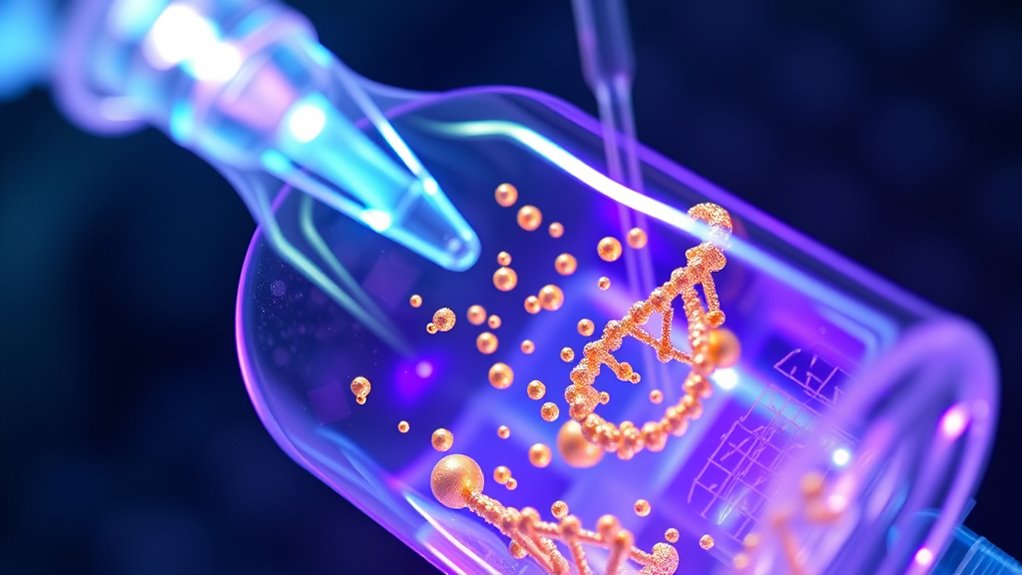Nanotech in gene therapy uses tiny particles called nanoparticles to deliver genetic material or gene editing tools directly to your targeted cells. These particles protect the genetic payload and help it pass through biological barriers, improving precision and reducing side effects. Combining nanotechnology with tools like CRISPR allows for more accurate and safer gene modifications. If you want to discover how these innovations are shaping future treatments, keep exploring the exciting possibilities further.
Key Takeaways
- Nanoparticles serve as delivery vehicles for genetic material, protecting it and ensuring targeted transport into cells.
- Nanotechnology enables crossing biological barriers, improving gene therapy efficiency and reducing side effects.
- Integration with gene editing tools like CRISPR enhances precision, safety, and effectiveness of genetic modifications.
- Stimuli-responsive nanoparticles allow controlled, site-specific release of therapeutic genes or gene editors.
- Advances in nanotech promise personalized, safer treatments for genetic disorders and cancer through targeted gene therapy.

Have you ever wondered how tiny particles can revolutionize medicine? Well, in the world of gene therapy, nanotechnology plays an essential role. Imagine using minuscule particles—so small they’re measured in nanometers—to deliver genetic material directly into cells. This process, called nanoparticle delivery, allows you to target specific tissues or even individual cells with remarkable precision. Unlike traditional methods, which often struggle with side effects or limited accuracy, nanoparticle delivery guarantees that therapies reach their intended destinations efficiently. These nanoparticles can be engineered from various materials, such as lipids or polymers, to protect genetic payloads from degradation and facilitate crossing biological barriers like cell membranes. This means fewer doses and reduced risks, making treatments more effective.
Once inside the cell, these nanoparticles release their cargo—be it DNA, RNA, or other genetic materials—enabling you to modify genes at their source. This is where gene editing techniques come into play. Technologies like CRISPR-Cas9 have transformed gene therapy by allowing precise, targeted modifications to an organism’s DNA. When combined with nanoparticle delivery, gene editing becomes even more powerful. The nanoparticles act as vehicles that carry the gene editing machinery directly into the right cells, minimizing off-target effects and enhancing safety. This synergy makes gene therapy more accessible and effective for a range of conditions, from inherited disorders to cancers.
Nanoparticles deliver gene editors precisely, reducing risks and boosting the effectiveness of gene therapies.
By integrating nanotech with gene editing, you gain the ability to customize treatments at an unprecedented level. Instead of broad-spectrum approaches, therapies can be tailored to an individual’s unique genetic makeup. For example, you could deliver gene editors precisely where they’re needed to correct mutations or deactivate harmful genes. This targeted approach not only improves outcomes but also reduces collateral damage to healthy tissues.
Furthermore, advancements in nanoparticle design continually improve the efficiency of gene editing techniques. Researchers are developing smarter nanoparticles that respond to specific stimuli—such as pH or temperature—ensuring that the genetic payload is released only in the desired environment. Innovative nanoparticle engineering is opening new frontiers in precision medicine, enabling you to design more effective delivery systems tailored to specific diseases. The potential here is vast: from curing genetic diseases to personalized cancer treatments, nanotech enables you to rethink what’s possible in medicine. As these technologies evolve, they promise safer, more effective therapies that could change lives. So, the next time you hear about breakthroughs in gene therapy, remember that tiny particles are at the heart of making these innovations a reality.
Frequently Asked Questions
Are Nanotech-Based Gene Therapies Safe for Long-Term Use?
Nanotech-based gene therapies show promise, but their long-term effects are still being studied. You might experience an immune response, which could cause side effects or reduce therapy effectiveness over time. Researchers are actively investigating safety and durability, but right now, you should stay informed about ongoing clinical trials and updates. While the technology is promising, it’s important to weigh potential benefits against unknown long-term risks before considering this treatment option.
How Cost-Effective Is Nanotech in Gene Therapy Treatments?
Think of nanotech in gene therapy like planting a young sapling—initially costly but with proper care, it grows into a sturdy tree. It’s fairly cost-effective long-term due to ongoing cost reduction and manufacturing scalability improvements. As technology advances, production becomes more efficient, lowering prices and making treatments more accessible. So, while upfront costs may seem high, the overall investment pays off as the technology matures and spreads.
Can Nanotech Improve Targeting Precision in Gene Editing?
Yes, nanotech can improve targeting precision in gene editing by utilizing nanoparticle delivery systems designed for molecular targeting. These nanoparticles can specifically bind to certain cell types or tissues, ensuring that gene editing tools like CRISPR are delivered exactly where needed. This precise delivery reduces off-target effects, enhances treatment safety, and increases efficiency, making nanotech a powerful tool for advancing gene editing accuracy.
What Are Potential Ethical Concerns With Nanotech Gene Therapies?
Did you know that over 60% of people worry about genetic privacy with advanced therapies? When considering nanotech gene therapies, ethical concerns arise, especially around protecting your genetic privacy and preventing unintended consequences. You might face dilemmas about consent, potential misuse, or long-term impacts. It’s vital to address these issues now to guarantee responsible development and safeguard individual rights as this technology advances.
How Soon Will Nanotech Gene Therapies Become Widely Available?
You might see nanotech gene therapies become widely available within the next 5 to 10 years, but delivery challenges and regulatory hurdles could delay their accessibility. As scientists work to improve delivery methods, regulators will need to establish safety standards. Staying informed about ongoing research and policy developments can help you understand when these therapies might reach broader populations, potentially revolutionizing personalized medicine in the near future.
Conclusion
As you explore the domain of nanotech in gene therapy, remember it’s like wielding a precision scalpel in a vast, complex landscape. This tiny technology acts as a masterful navigator, guiding genetic material to its destination with unmatched accuracy. With each breakthrough, you’re witnessing the dawn of a new era—where hope blooms like a carefully tended garden. Embrace this journey, for nanotech’s promise is a beacon illuminating the path toward healing and transformation.









